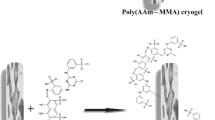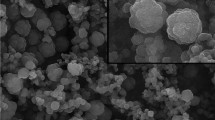Abstract
Horseradish peroxidase (HRP) was immobilized on the polyaniline (PANI) grafted polyacrylonitrile (PAN) films. The maximum HRP immobilization capacity of the PAN-g-PANI-3 film was 221 μg/cm2. The HRP-immobilized PAN-g-PANI-3 film retained 79 % of the activity of the same quantity free enzyme. The HRP-immobilized PAN-g-PANI-3 film was operated for the decolorization of two different benzidine-based dyes in the presence of hydrogen peroxide. The maximum decolorization grade was obtained at pH 6.0 for both dyes. The HRP-immobilized PAN-g-PANI-3 film was very effective for removal of Direct Blue-53 compared to Direct Black-38 from aqueous solutions. The immobilized HRP exhibited high resistance to proteolysis by trypsin compared to the free counterpart. Immobilized HRP preserved 83 % of its original activity even after 8 weeks of storage at 4 °C, while the free enzyme lost its initial activity after 3 weeks of storage period.








Similar content being viewed by others
References
Gomez JL, Bodalo A, Gomez E, Bastida J, Hidalgo AM, Gomez M (2006) Immobilization of peroxidases on glass beads: an improved alternative for phenol removal. Enzyme Microb Technol 39:1016–1022
Bhunia A, Durant S, Wangikar PP (2001) Horseradish peroxidase catalyzed degradation of industrially important dyes. Biotechnol Bioeng 72:562–567
Matto M, Husain Q (2009) Decolorization of textile effluent by bitter gourd peroxidase immobilized on concanavalin A layered calcium alginate–starch beads. J Hazard Mater 164:1540–1546
Osma JF, Toca-Herrera JL, Rodriguez-Couto S (2010) Transformation pathway of Remazol Brilliant Blue R by immobilised laccase. Bioresour Technol 101:8509–8514
Colborn T (2006) A case for revisiting the safety of pesticides: a closer look at neurodevelopment. Environ Health Perspect 114:10–17
Lowry LK, Tolos WP, Boeniger MF, Nony CR, Bowman MC (1980) Chemical monitoring of urine from workers potentially exposed to benzidine derived azo dyes. Toxicol Lett 71:29–36
Rinde E, Troll W (1975) Metabolic reduction of benzidine azo dyes to benzidine in the rhesus monkey. J Natl Cancer Inst 55:181–182
You XY, Chen JG, Hu YN (1990) Studies on the relation between bladder cancer and benzidine or its derived dyes in Shanghai. Br J Ind Med 47:544–552
Kavlock RJ, Daston GP, DeRosa C, Fenner-Crisp P, Gray LE, Kaattari S, Lucier G, Luster M, Mac MJ, Maczka C, Miller R, Moore J, Rolland R, Scott G, Sheehan DM, Sinks T, Tilson HA (1996) Research needs for the risk assessment of health and environmental effects of endocrine disruptors: a report of the US EPA-sponsored workshop. Environ Health Perspect 104:714–740
Cristovao R, Tavares APM, Brigida AI, Loureiro JM, Boaventura RAR, Macedo EA, Coelho MAZ (2011) Immobilization of commercial laccase onto green coconut fiber by adsorption and its application for reactive textile dyes degradation. J Mol Catal B 72:6–12
Bafana A, Krishnamurthi K, Devi SS, Chakrabarti T (2008) Biological decolourization of C.I. Direct Black 38 by E. gallinarum. J Hazard Mater 157:187–193
Karim Z, Husain Q (2010) Application of fly ash adsorbed peroxidase for the removal of bisphenol A in batch process and continuous reactor: Assessment of genotoxicity of its product. Food Chem Toxicol 48:385–3390
Qiu W, Zhang K, Liu J, Koros WJ, Sun Q, Deng Y (2010) Macroporous polymeric sorbents with high selectivity for separation of phenols. Polymer 51:3793–3800
Arica MY, Altıntas B, Bayramoglu G (2011) Immobilization of laccase onto spacer-arm attached non-porous poly(GMA/EGDMA) beads: application for textile dye degradation. Bioresour Technol 100:665–669
Bayramoglu G, Arica MY (2008) Enzymatic removal of phenol and p-chloropheol in enzyme reactor: horseradish peroxidase immobilized on magnetic beads. J Hazard Mater 156:148–155
Arica MY (2000) Immobilization of polyphenol oxidase on carboxymethylcellulose hydrogels beads: preparation and characterization. Polym Int 49:775–781
Arica MY, Bayramoglu G (2004) Reversible immobilization of tyrosinase onto polyethyleneimine grafted and Cu(II) chelated poly(HEMA-co-GMA) reactive film. J Mol Catal B 27:255–265
Zhang J, Ye P, Chen S, Wang W (2007) Removal of pentachlorophenol by immobilized horseradish peroxidase. Int Biodeterior Biodegrad 59:307–314
Karagoz B, Bayramoglu G, Altintas B, Bicak N, Arica MY (2011) Amine functional monodisperse microbeads via precipitation polymerization of N-vinyl formamide: immobilized laccase for benzidine based dyes degradation. Bioresour Technol 102:6783–6790
Xu J, Tang T, Zhang K, Ai S, Du H (2011) Electroenzymatic catalyzed oxidation of bisphenol-A using HRP immobilized on magnetic silk fibroin nanoparticles. Process Biochem 46:1160–1165
Tang T, Fan H, Ai S, Han R, Qiu Y (2011) Hemoglobin (Hb) immobilized on amino-modified magnetic nanoparticles for the catalytic removal of bisphenol A. Chemosphere 83:255–264
Bayramoglu G, Yilmaz M, Arica MY (2010) Preparation and characterization of epoxy-functionalized magnetic chitosan beads: laccase immobilized for degradation of reactive dyes. Bioprocess Biosyst Eng 33:439–448
Akhtar S, Khan AA, Husain Q (2005) Potential of immobilized bitter gourd (Momordica charantia) peroxidases in the decolorization and removal of textile dyes from polluted wastewater and dyeing effluent. Chemosphere 60:291–301
Bayramoglu G, Yilmaz M, Arica MY (2010) Reversible immobilization of laccase to poly(4-vinylpyridine) grafted and Cu(II) chelated magnetic beads: biodegradation of reactive dyes. Bioresour Technol 101:6615–6621
Osma JF, Toca-Herrera JL, Rodriguez-Couto S (2010) Biodegradation of a simulated textile effluent by immobilized-coated laccase in laboratory-scale reactors. Appl Catal A 373:147–153
Georgieva S, Godjevargova T, Mita DG, Diano N, Menale C, Nicolucci C, Romano C, Mita CL, Golovinsky E (2010) Non-isothermal bioremediation of waters polluted by phenol and some of its derivatives by laccase covalently immobilized on polypropylene membranes. J Mol Catal B 66:210–218
Wang F, Guo C, Yang L-R, Liu C-Z (2010) Magnetic mesoporous silica nanoparticles: fabrication and their laccase immobilization performance. Bioresour Technol 101:8931–8935
Absalan G, Asadi M, Kamran S, Sheikhian L, Goltz DM (2011) Removal of reactive red-120 and 4-(2-pyridylazo) resorcinol from aqueous samples by Fe3O4 magnetic nanoparticles using ionic liquid as modifier. J Hazard Mater 192:476–484
Quintanilla-Guerrero F, Duarte-Vazquez MA, Garcia-Almendarez BE, Tinoco R, Vazquez-Duhalt R, Regalado C (2008) Polyethylene glycol improves phenol removal by immobilized turnip peroxidase. Bioresour Technol 99:8605–8611
Ozoner SK, Yilmaz F, Celik A, Keskinler B, Erhan E (2011) A novel poly(glycine methacrylate-co-3-thienylmethyl methacrylate)-polypyrrole-carbon nanotube-horseradish peroxidase composite film electrode for the detection of phenolic compounds. Curr Appl Phys 11:402–408
Ashraf H, Husain Q (2010) Use of DEAE cellulose adsorbed and cross-linked white radish (Raphanus sativus) peroxidase for the removal of α-naphthol in batch and continuous process. Int Biodeterior Biodegrad 64:27–31
Shao J, Huang L-L, Yang YM (2009) Immobilization of polyphenol oxidase on alginate–SiO2 hybrid gel: stability and preliminary applications in the removal of aqueous phenol. J Chem Technol Biotechnol 84:633–635
Gomez JL, Bodalo A, Gomez E, Hidalgo AM, Gomez M, Murcia MD (2007) Experimental behaviour and design model of a fluidized bed reactor with immobilized peroxidase for phenol removal. Chem Eng J 127:47–57
Carrasco JLG, Gomez EG, Maximo MF, Gomez MG, Murcia MD, Requena SO (2011) A diffusion-reaction kinetic model for the removal of aqueous 4-chlorophenol with immobilized peroxidase. Chem Eng J 166:693–703
Zhang F, Zheng B, Zhang J, Huang X, Liu H, Guo S, Zhang J (2010) Horseradish peroxidase immobilized on graphene oxide: physical properties and applications in phenolic compound removal. J Phys Chem C 114:8469–8473
Bayramoglu G, Arica MY (2009) Immobilization of laccase onto poly(glycidyl methacrylate) brush grafted poly(hydroxyethylmethacrylate) films: enzymatic oxidation of phenolic compounds. Mater Sci Eng C 29:1990–1997
Bayramoglu G, Altıntas B, Arica MY (2011) Reversible immobilization of uricase on conductive polyaniline brushes grafted on polyacrylonitrile film. Bioprocess Biosyst Eng 34:127–134
Guiseppi-Elie A (2010) Electroconductive hydrogels: synthesis, characterization and biomedical applications. Biomaterials 31:2701–2716
Bayramoglu G, Karakısla M, Altıntas B, Metin AU, Sacak M, Arica MY (2009) Polyaniline grafted polyacylonitrile conductive composite fibers for reversible immobilization of enzymes: stability and catalytic properties of invertase. Process Biochem 44:880–885
Bayramoglu G, Metin AU, Arica MY (2010) Surface modification of polyacrylonitrile film by anchoring conductive polyaniline and determination of uricase adsorption capacity and activity. Appl Surf Sci 256:6710–6716
Ashly PC, Joseph MJ, Mohanan PV (2011) Activity of diastase α-amylase immobilized on polyanilines (PANIs). Food Chem 127:1808–1813
Bradford M (1976) A rapid and sensitive method for the quantitation of microgram quantities of protein utilizing the principle of protein-dye binding. Anal Biochem 72:248–254
Bayramoglu G, Senel AU, Yilmaz M, Arica MY (2008) Preparation of nanofibrous polymer grafted magnetic poly(GMA-MMA)-g-MAA beads for immobilization of trypsin via adsorption. Biochem Eng J 40:262–274
Yang LJ, Guiseppi-Wilson A, Guiseppi-Elie A (2011) Design considerations in the use of interdigitated microsensor electrode arrays (IMEs) for impedimetric characterization of biomimetic hydrogels. Biomed Microdevices 13:279–289
Bayramoglu G, Altıntas B, Yilmaz M, Arica MY (2011) Immobilization of chloroperoxidase onto highly hydrophilic polyethylene chains via bioconjugation: catalytic properties and stabilities. Bioresour Technol 102:475–482
Kulshrestha Y, Husain Q (2006) Direct immobilization of peroxidase on DEAE cellulose from ammonium sulphate fractionated proteins of bitter gourd (Momordica charantia). Enzyme Microb Technol 38:470–477
Mohamed SA, Aly AS, Mohamed TM, Salah HA (2008) Immobilization of horseradish peroxidase on nonwoven polyester fabric coated with chitosan. Appl Biochem Biotechnol 144:169–179
Li Z, Liu W, Chen XF, Shang WL (2009) Research on the application of horseradish peroxidase and hydrogen peroxide to the oil removal of oily water. Water Sci Technol 59:1751–1758
Mohan SV, Prasad KK, Rao NC, Sarma PN (2005) Acid azo dye degradation by free and immobilized horseradish peroxidase (HRP) catalyzed process Acid azo dye degradation by free and immobilized horseradish peroxidase (HRP) catalyzed process. Chemosphere 58:1097–1105
Gomez JL, Bodalo A, Gomez E, Bastida J, Hidalgo AM, Gomez M (2006) Immobilization of peroxidases on glass beads: an improved alternative for phenol removal. Enzyme Microb Technol 39:1016–1022
Author information
Authors and Affiliations
Corresponding author
Rights and permissions
About this article
Cite this article
Bayramoglu, G., Altintas, B. & Yakup Arica, M. Cross-linking of horseradish peroxidase adsorbed on polycationic films: utilization for direct dye degradation. Bioprocess Biosyst Eng 35, 1355–1365 (2012). https://doi.org/10.1007/s00449-012-0724-2
Received:
Accepted:
Published:
Issue Date:
DOI: https://doi.org/10.1007/s00449-012-0724-2




